Health Assessment (42)
Health Assessment Basics
-
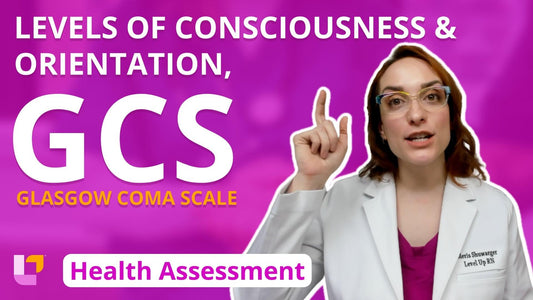
Health Assessment, part 3: Levels of Consciousness and Orientation, Glasgow Coma Scale
Meris Shuwarger BSN, RN, CEN, TCRNHow to assess a patient's level of consciousness and orientation, and how to score a patient using the Glasgow coma scale.
Health Assessment, part 3: Levels of Consciousness and Orientation, Glasgow Coma Scale
Meris Shuwarger BSN, RN, CEN, TCRNHow to assess a patient's level of consciousness and orientation, and how to score a patient using the Glasgow coma scale.
-

Health Assessment, part 2: Physical Assessment Steps, Beginning an Assessment, & General Survey
Meris Shuwarger BSN, RN, CEN, TCRNThe general overview of physical assessments, how to begin an assessment, and what is covered by a general survey.
1 commentHealth Assessment, part 2: Physical Assessment Steps, Beginning an Assessment, & General Survey
Meris Shuwarger BSN, RN, CEN, TCRNThe general overview of physical assessments, how to begin an assessment, and what is covered by a general survey.
1 comment -

Health Assessment, part 1: Physical Assessment Components
Meris Shuwarger BSN, RN, CEN, TCRNThe four main types of physical assessment components (i.e., inspection, palpation, percussion, and auscultation) and discusses the flow of a general physical assessment and abdominal assessment.
Health Assessment, part 1: Physical Assessment Components
Meris Shuwarger BSN, RN, CEN, TCRNThe four main types of physical assessment components (i.e., inspection, palpation, percussion, and auscultation) and discusses the flow of a general physical assessment and abdominal assessment.
Vital Signs & Pain Assessment
-

Health Assessment, part 10: Pain Assessment
Meris Shuwarger BSN, RN, CEN, TCRNThe different components of a pain assessment, and covers several different pain scales (e.g., CRIES, FLACC, FACES, Oucher, numeric)
Health Assessment, part 10: Pain Assessment
Meris Shuwarger BSN, RN, CEN, TCRNThe different components of a pain assessment, and covers several different pain scales (e.g., CRIES, FLACC, FACES, Oucher, numeric)
-

Health Assessment, part 9: Orthostatic Vital Signs
Meris Shuwarger BSN, RN, CEN, TCRNWhen and how to assess orthostatic vital signs, orthostatic hypotension criteria, and important patient teaching
Health Assessment, part 9: Orthostatic Vital Signs
Meris Shuwarger BSN, RN, CEN, TCRNWhen and how to assess orthostatic vital signs, orthostatic hypotension criteria, and important patient teaching
-

Health Assessment, part 8: Assessing Blood Pressure
Meris Shuwarger BSN, RN, CEN, TCRNThe assessment technique when obtaining a patient's blood pressure, along with the expected blood pressure ranges by age, and levels of hypertension for adults
Health Assessment, part 8: Assessing Blood Pressure
Meris Shuwarger BSN, RN, CEN, TCRNThe assessment technique when obtaining a patient's blood pressure, along with the expected blood pressure ranges by age, and levels of hypertension for adults
-

Health Assessment, part 7: Assessing Oxygen Saturation
Meris Shuwarger BSN, RN, CEN, TCRNHow to assess your patient's oxygen saturation, the expected oxygen saturation range, and nursing considerations when obtaining this vital sign.
Health Assessment, part 7: Assessing Oxygen Saturation
Meris Shuwarger BSN, RN, CEN, TCRNHow to assess your patient's oxygen saturation, the expected oxygen saturation range, and nursing considerations when obtaining this vital sign.
-

Health Assessment, part 6: Assessing Respirations
Meris Shuwarger BSN, RN, CEN, TCRNThe assessment components and technique of obtaining your patient's respirations, along with expected findings (e.g., expected respiratory rate ranges, depth, rhythm, and effort), and unexpected findings (e.g., tachypnea, bradypnea, hyperventilation,...
Health Assessment, part 6: Assessing Respirations
Meris Shuwarger BSN, RN, CEN, TCRNThe assessment components and technique of obtaining your patient's respirations, along with expected findings (e.g., expected respiratory rate ranges, depth, rhythm, and effort), and unexpected findings (e.g., tachypnea, bradypnea, hyperventilation,...
-
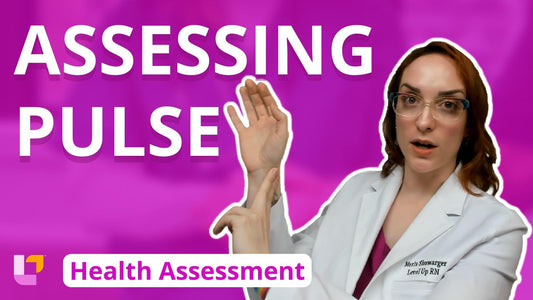
Health Assessment, part 5: Assessing Pulse
Meris Shuwarger BSN, RN, CEN, TCRNWhat and how to assess when obtaining a patient's pulse, along with the expected findings (e.g., expected ranges, regularity, strength, and equality) and unexpected findings (e.g., bradycardia, irregular pulses, pulsus...
Health Assessment, part 5: Assessing Pulse
Meris Shuwarger BSN, RN, CEN, TCRNWhat and how to assess when obtaining a patient's pulse, along with the expected findings (e.g., expected ranges, regularity, strength, and equality) and unexpected findings (e.g., bradycardia, irregular pulses, pulsus...
-

Health Assessment, part 4: Assessing Temperature
Meris Shuwarger BSN, RN, CEN, TCRNHow to assess temperature (e.g., oral, temporal, tympanic, axillary, and rectal), the expected temperature ranges for adults, children, and infants, and nursing considerations when taking a patient's temperature.
Health Assessment, part 4: Assessing Temperature
Meris Shuwarger BSN, RN, CEN, TCRNHow to assess temperature (e.g., oral, temporal, tympanic, axillary, and rectal), the expected temperature ranges for adults, children, and infants, and nursing considerations when taking a patient's temperature.
Skin & Nails Assessment
-

Health Assessment, part 14: Nail Assessment
Meris Shuwarger BSN, RN, CEN, TCRNImportant components of assessing a patient's nails and reviews nail clubbing and capillary refill
1 commentHealth Assessment, part 14: Nail Assessment
Meris Shuwarger BSN, RN, CEN, TCRNImportant components of assessing a patient's nails and reviews nail clubbing and capillary refill
1 comment -

Health Assessment, part 13: Primary and Secondary Skin Lesions
Meris Shuwarger BSN, RN, CEN, TCRNPrimary skin lesions (e.g., macule, patch, papule, plaque, wheal, vesicle, pustule, bulla, nodule, tumor) and secondary skin lesions (e.g., crust, scale, fissure, ero sion, ulcer, keloid, atrophy)
Health Assessment, part 13: Primary and Secondary Skin Lesions
Meris Shuwarger BSN, RN, CEN, TCRNPrimary skin lesions (e.g., macule, patch, papule, plaque, wheal, vesicle, pustule, bulla, nodule, tumor) and secondary skin lesions (e.g., crust, scale, fissure, ero sion, ulcer, keloid, atrophy)
-

Health Assessment, part 12: Skin Color Alterations & Edema
Meris Shuwarger BSN, RN, CEN, TCRNHow to assess alterations in your patient's skin color (e.g., pallor, cyanosis, erythema, jaundice) and how to assess edema (e.g., pitting edema and non-pitting edema)
Health Assessment, part 12: Skin Color Alterations & Edema
Meris Shuwarger BSN, RN, CEN, TCRNHow to assess alterations in your patient's skin color (e.g., pallor, cyanosis, erythema, jaundice) and how to assess edema (e.g., pitting edema and non-pitting edema)
-

Health Assessment, part 11: Skin Assessment
Meris Shuwarger BSN, RN, CEN, TCRNThe overall components of a skin assessment and covers information about assessing skin turgor.
Health Assessment, part 11: Skin Assessment
Meris Shuwarger BSN, RN, CEN, TCRNThe overall components of a skin assessment and covers information about assessing skin turgor.
Head & Neck Assessment
-

Health Assessment, part 20: Mouth & Throat Assessment
Meris Shuwarger BSN, RN, CEN, TCRNHow to assess the mouth and throat, including how to size tonsils.
Health Assessment, part 20: Mouth & Throat Assessment
Meris Shuwarger BSN, RN, CEN, TCRNHow to assess the mouth and throat, including how to size tonsils.
-
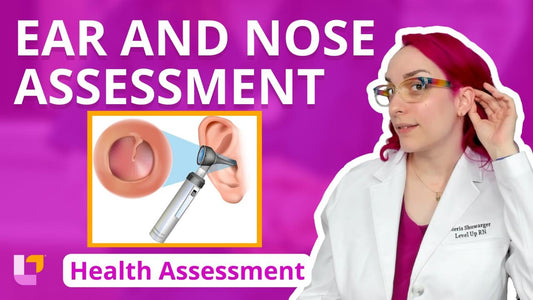
Health Assessment, part 19: Ear and Nose Assessment
Meris Shuwarger BSN, RN, CEN, TCRNThe components of the ear and nose assessment, including internal inspection with an otoscope and visualization of the tympanic membrane and cone of light.
Health Assessment, part 19: Ear and Nose Assessment
Meris Shuwarger BSN, RN, CEN, TCRNThe components of the ear and nose assessment, including internal inspection with an otoscope and visualization of the tympanic membrane and cone of light.
-

Health Assessment, part 18: Eye Assessment
Meris Shuwarger BSN, RN, CEN, TCRNThe components of a normal eye assessment, including the pupillary light reflex and assessing for accommodation.
Health Assessment, part 18: Eye Assessment
Meris Shuwarger BSN, RN, CEN, TCRNThe components of a normal eye assessment, including the pupillary light reflex and assessing for accommodation.
-

Health Assessment, part 17: Unexpected Findings of the Neck
Meris Shuwarger BSN, RN, CEN, TCRNUnexpected findings of the neck assessment (e.g., tracheal deviation, lymphadenopathy, goiter, jugular venous distention, and carotid bruit).
Health Assessment, part 17: Unexpected Findings of the Neck
Meris Shuwarger BSN, RN, CEN, TCRNUnexpected findings of the neck assessment (e.g., tracheal deviation, lymphadenopathy, goiter, jugular venous distention, and carotid bruit).
-

Health Assessment, part 16: Neck Assessment, Lymph Nodes, & Vessels
Meris Shuwarger BSN, RN, CEN, TCRNAssessment of the neck, including assessment of the lymph nodes and the vessels of the neck
Health Assessment, part 16: Neck Assessment, Lymph Nodes, & Vessels
Meris Shuwarger BSN, RN, CEN, TCRNAssessment of the neck, including assessment of the lymph nodes and the vessels of the neck
-

Health Assessment, part 15: Head & Face Assessment
Meris Shuwarger BSN, RN, CEN, TCRNMeris reviews the basics of the head and face assessment. Be sure to stay to the end to test your knowledge of key facts provided in this video using Meris's...
1 commentHealth Assessment, part 15: Head & Face Assessment
Meris Shuwarger BSN, RN, CEN, TCRNMeris reviews the basics of the head and face assessment. Be sure to stay to the end to test your knowledge of key facts provided in this video using Meris's...
1 comment
Cranial Nerve Assessment
-

Health Assessment, part 29: Cranial Nerve XI - Spinal Accessory & Cranial Nerve XII - Hypoglossal
Meris Shuwarger BSN, RN, CEN, TCRNNumber, name, type, function, and assessment of cranial nerves XI (spinal accessory) and XII (hypoglossal).
Health Assessment, part 29: Cranial Nerve XI - Spinal Accessory & Cranial Nerve XII - Hypoglossal
Meris Shuwarger BSN, RN, CEN, TCRNNumber, name, type, function, and assessment of cranial nerves XI (spinal accessory) and XII (hypoglossal).
-

Health Assessment, part 28: Cranial Nerve IX - Glossopharyngeal & Cranial Nerve X - Vagus
Meris Shuwarger BSN, RN, CEN, TCRNNumber, name, type, function, and assessment of cranial nerves IX (glossopharyngeal) and X (vagus).
Health Assessment, part 28: Cranial Nerve IX - Glossopharyngeal & Cranial Nerve X - Vagus
Meris Shuwarger BSN, RN, CEN, TCRNNumber, name, type, function, and assessment of cranial nerves IX (glossopharyngeal) and X (vagus).
-

Health Assessment, part 27: Cranial Nerve VIII - Vestibulocochlear/Acoustic
Meris Shuwarger BSN, RN, CEN, TCRNNumber, name, type, function, and assessment (e.g., whisper test, Rinne test, Weber test) of cranial nerve VIII (vestibulocochlear/acoustic).
Health Assessment, part 27: Cranial Nerve VIII - Vestibulocochlear/Acoustic
Meris Shuwarger BSN, RN, CEN, TCRNNumber, name, type, function, and assessment (e.g., whisper test, Rinne test, Weber test) of cranial nerve VIII (vestibulocochlear/acoustic).
-
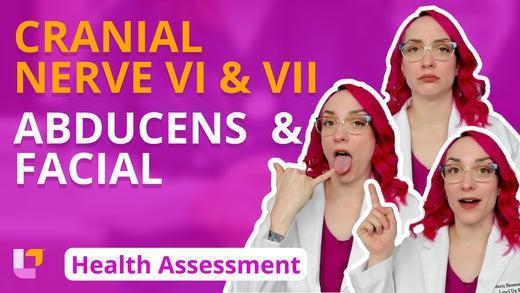
Health Assessment, part 26: Cranial Nerve VI - Abducens & Cranial Nerve VII - Facial
Meris Shuwarger BSN, RN, CEN, TCRNNumber, name, type, function, and assessment of cranial nerves VI (abducens) and VII (facial).
Health Assessment, part 26: Cranial Nerve VI - Abducens & Cranial Nerve VII - Facial
Meris Shuwarger BSN, RN, CEN, TCRNNumber, name, type, function, and assessment of cranial nerves VI (abducens) and VII (facial).
-
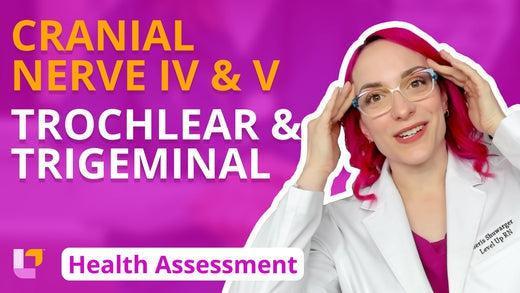
Health Assessment, part 25: Cranial Nerve IV - Trochlear & Cranial Nerve V - Trigeminal
Meris Shuwarger BSN, RN, CEN, TCRNNumber, name, type, function, and assessment (e.g., corneal reflex, cotton wisp test) of cranial nerve IV (trochlear) and V (trigeminal).
Health Assessment, part 25: Cranial Nerve IV - Trochlear & Cranial Nerve V - Trigeminal
Meris Shuwarger BSN, RN, CEN, TCRNNumber, name, type, function, and assessment (e.g., corneal reflex, cotton wisp test) of cranial nerve IV (trochlear) and V (trigeminal).
-

Health Assessment, part 24: Cranial Nerve III - Oculomotor
Meris Shuwarger BSN, RN, CEN, TCRNMeris reviews the number, name, type, function, and assessment (e.g., corneal light reflex, cover test, and six cardinal positions of gaze) of cranial nerve III (oculomotor).
Health Assessment, part 24: Cranial Nerve III - Oculomotor
Meris Shuwarger BSN, RN, CEN, TCRNMeris reviews the number, name, type, function, and assessment (e.g., corneal light reflex, cover test, and six cardinal positions of gaze) of cranial nerve III (oculomotor).
-

Health Assessment, part 23: Cranial Nerve II - Optic
Meris Shuwarger BSN, RN, CEN, TCRNMeris reviews the number, name, type, function, and assessment (e.g., Snellen test, Jaeger test, Ishihara color test, and confrontation test) of cranial nerve II (optic).
Health Assessment, part 23: Cranial Nerve II - Optic
Meris Shuwarger BSN, RN, CEN, TCRNMeris reviews the number, name, type, function, and assessment (e.g., Snellen test, Jaeger test, Ishihara color test, and confrontation test) of cranial nerve II (optic).
-

Health Assessment, part 22: Cranial Nerve I - Olfactory
Meris Shuwarger BSN, RN, CEN, TCRNMeris reviews how to assess the number, name, type, and function of cranial nerve I (olfactory).
Health Assessment, part 22: Cranial Nerve I - Olfactory
Meris Shuwarger BSN, RN, CEN, TCRNMeris reviews how to assess the number, name, type, and function of cranial nerve I (olfactory).
-

Health Assessment, part 21: Cranial Nerve Overview
Meris Shuwarger BSN, RN, CEN, TCRNThe number, name, type, and function(s) of all 12 cranial nerves, and two helpful mnemonics to remember their names and types.
Health Assessment, part 21: Cranial Nerve Overview
Meris Shuwarger BSN, RN, CEN, TCRNThe number, name, type, and function(s) of all 12 cranial nerves, and two helpful mnemonics to remember their names and types.
Chest & Abdomen Assessment
-
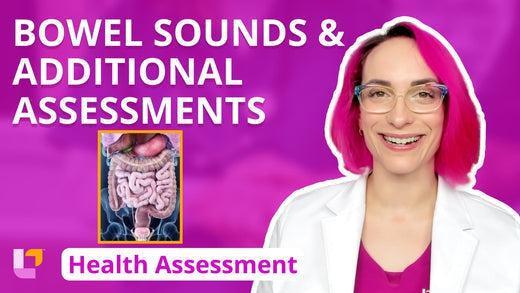
Health Assessment, part 37: Bowel Sounds & Additional Assessments
Meris Shuwarger BSN, RN, CEN, TCRNExpected and unexpected findings when auscultating bowel sounds, along with how to assess for rebound tenderness, Murphy's sign, and McBurney's point.
Health Assessment, part 37: Bowel Sounds & Additional Assessments
Meris Shuwarger BSN, RN, CEN, TCRNExpected and unexpected findings when auscultating bowel sounds, along with how to assess for rebound tenderness, Murphy's sign, and McBurney's point.
-

Health Assessment, part 36: Abdominal Assessment
Meris Shuwarger BSN, RN, CEN, TCRNComponents of the abdominal assessment, including how to auscultate the bowel sounds and how to palpate the abdomen.
Health Assessment, part 36: Abdominal Assessment
Meris Shuwarger BSN, RN, CEN, TCRNComponents of the abdominal assessment, including how to auscultate the bowel sounds and how to palpate the abdomen.
-
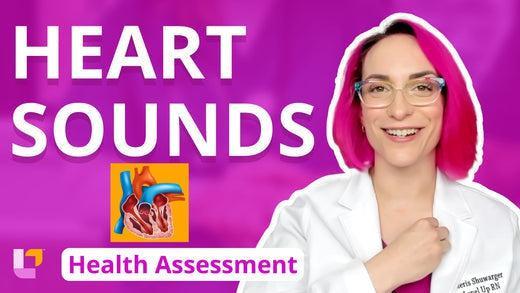
Health Assessment, part 35: Heart Sounds
Meris Shuwarger BSN, RN, CEN, TCRNHow to assess the heart, including how to use the diaphragm and bell of a stethoscope, auscultating the aortic valve, pulmonic valve, Erb's point, tricuspid valve, and mitral valve. Expected...
Health Assessment, part 35: Heart Sounds
Meris Shuwarger BSN, RN, CEN, TCRNHow to assess the heart, including how to use the diaphragm and bell of a stethoscope, auscultating the aortic valve, pulmonic valve, Erb's point, tricuspid valve, and mitral valve. Expected...
-

Health Assessment, part 34: Whispered Pectoriloquy & Egophony
Meris Shuwarger BSN, RN, CEN, TCRNAdditional lung assessments, including whispered pectoriloquy and egophony.
Health Assessment, part 34: Whispered Pectoriloquy & Egophony
Meris Shuwarger BSN, RN, CEN, TCRNAdditional lung assessments, including whispered pectoriloquy and egophony.
-
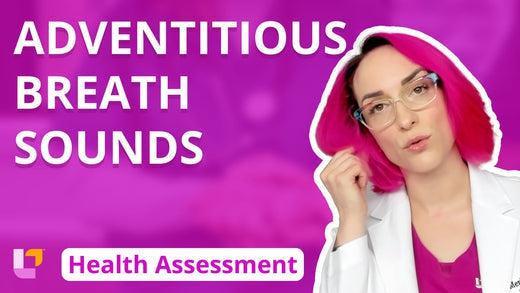
Health Assessment, part 33: Adventitious Breath Sounds
Meris Shuwarger BSN, RN, CEN, TCRNTypes, qualities, and some possible causes for adventitious breath sounds (e.g., fine crackles, coarse crackles, wheeze, rhonchi, friction rub).
Health Assessment, part 33: Adventitious Breath Sounds
Meris Shuwarger BSN, RN, CEN, TCRNTypes, qualities, and some possible causes for adventitious breath sounds (e.g., fine crackles, coarse crackles, wheeze, rhonchi, friction rub).
-
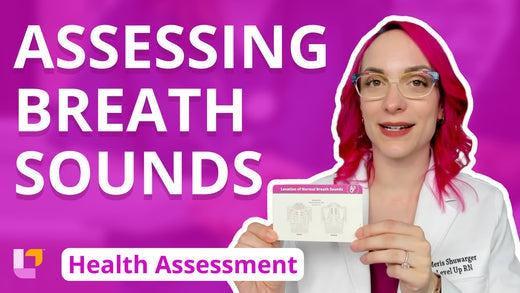
Health Assessment, part 32: Assessing Breath Sounds
Meris Shuwarger BSN, RN, CEN, TCRNPosterior chest auscultation sites along with the types and location of normal breath sounds (i.e., bronchial, bronchovesicular, vesicular).
Health Assessment, part 32: Assessing Breath Sounds
Meris Shuwarger BSN, RN, CEN, TCRNPosterior chest auscultation sites along with the types and location of normal breath sounds (i.e., bronchial, bronchovesicular, vesicular).
-
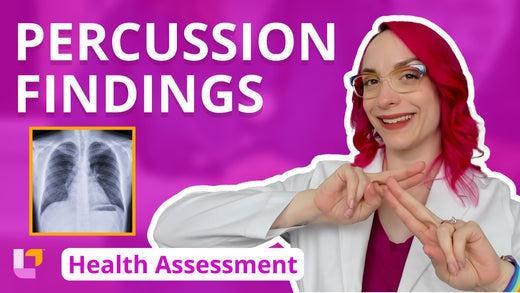
Health Assessment, part 31: Percussion Findings
Meris Shuwarger BSN, RN, CEN, TCRNFindings associated with indirect percussion (i.e., resonance, hyperresonance, dullness, flatness, and tympany).
Health Assessment, part 31: Percussion Findings
Meris Shuwarger BSN, RN, CEN, TCRNFindings associated with indirect percussion (i.e., resonance, hyperresonance, dullness, flatness, and tympany).
-

Health Assessment, part 30: Chest Assessment
Meris Shuwarger BSN, RN, CEN, TCRNBasics of assessing the anterior and posterior chest, including observing for the point of maximal impulse (PMI), lifts and heaves, AP:T chest ratio, and costovertebral angle (CVA) tenderness.
Health Assessment, part 30: Chest Assessment
Meris Shuwarger BSN, RN, CEN, TCRNBasics of assessing the anterior and posterior chest, including observing for the point of maximal impulse (PMI), lifts and heaves, AP:T chest ratio, and costovertebral angle (CVA) tenderness.
Musculoskeletal & Neurological Assessment
-

Health Assessment, part 42: Ending the Assessment
Meris Shuwarger BSN, RN, CEN, TCRNHow to conclude a head-to-toe assessment and provide for patient safety.
Health Assessment, part 42: Ending the Assessment
Meris Shuwarger BSN, RN, CEN, TCRNHow to conclude a head-to-toe assessment and provide for patient safety.
-

Health Assessment, part 41: Neurologic Assessment & Tests, Reflex Assessment
Meris Shuwarger BSN, RN, CEN, TCRNThe components of a neurologic assessment, including the Romberg test, assessing stereognosis and graphesthesia, and performing deep tendon reflex (DTR) assessment along with assessing for the presence of a Babinski...
Health Assessment, part 41: Neurologic Assessment & Tests, Reflex Assessment
Meris Shuwarger BSN, RN, CEN, TCRNThe components of a neurologic assessment, including the Romberg test, assessing stereognosis and graphesthesia, and performing deep tendon reflex (DTR) assessment along with assessing for the presence of a Babinski...
-

Health Assessment, part 40: Extremity Assessment & Tests
Meris Shuwarger BSN, RN, CEN, TCRNComponents of extremity assessment, along with reviewing some important upper extremity assessment tests (e.g., modified Allen test, Phalen test, Tinel test). Be sure to stay to the end to test...
Health Assessment, part 40: Extremity Assessment & Tests
Meris Shuwarger BSN, RN, CEN, TCRNComponents of extremity assessment, along with reviewing some important upper extremity assessment tests (e.g., modified Allen test, Phalen test, Tinel test). Be sure to stay to the end to test...
-

Health Assessment, part 39: Spinal Curvatures & Joint Movements
Meris Shuwarger BSN, RN, CEN, TCRNCurvatures of the spine (e.g., normal curvatures, kyphosis, lordosis, scoliosis) and joint movements (e.g., flexion, extension, abduction, adduction, circumduction, rotation).
Health Assessment, part 39: Spinal Curvatures & Joint Movements
Meris Shuwarger BSN, RN, CEN, TCRNCurvatures of the spine (e.g., normal curvatures, kyphosis, lordosis, scoliosis) and joint movements (e.g., flexion, extension, abduction, adduction, circumduction, rotation).
-
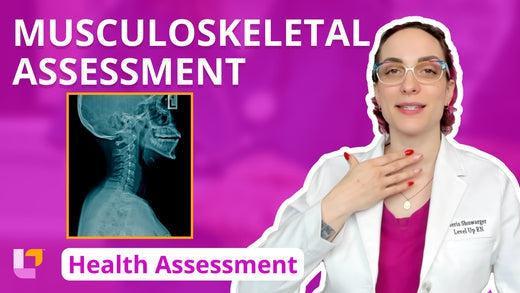
Health Assessment, part 38: Musculoskeletal Assessment
Meris Shuwarger BSN, RN, CEN, TCRNBasic components of a musculoskeletal assessment, including how to assess muscle strength.
Health Assessment, part 38: Musculoskeletal Assessment
Meris Shuwarger BSN, RN, CEN, TCRNBasic components of a musculoskeletal assessment, including how to assess muscle strength.










































